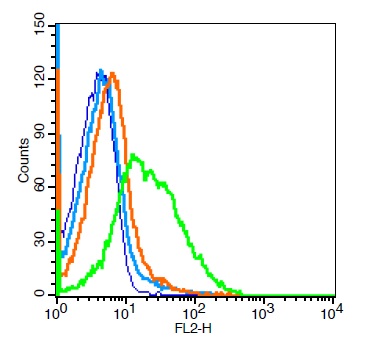anti-CD38 antibody [NIMR-5] (PE-Cyanine 5)
ARG20922
ApplicationsFlow Cytometry, ImmunoHistoChemistry, ImmunoHistoChemistry Frozen, Neutralisation/Blocking, Other Application
Product group Antibodies
ReactivityMouse
TargetCd38
Overview
- SupplierArigo Biolaboratories
- Product Nameanti-CD38 antibody [NIMR-5] (PE-Cyanine 5)
- Delivery Days Customer23
- ApplicationsFlow Cytometry, ImmunoHistoChemistry, ImmunoHistoChemistry Frozen, Neutralisation/Blocking, Other Application
- CertificationResearch Use Only
- ClonalityMonoclonal
- Clone IDNIMR-5
- Concentration0.1 mg/ml
- ConjugateTricolor
- Gene ID12494
- Target nameCd38
- Target descriptionCD38 antigen
- Target synonymsADPRC 1, Cd38-rs1, I-19, ADP-ribosyl cyclase/cyclic ADP-ribose hydrolase 1, 2'-phospho-ADP-ribosyl cyclase, 2'-phospho-ADP-ribosyl cyclase/2'-phospho-cyclic-ADP-ribose transferase, 2'-phospho-cyclic-ADP-ribose transferase, ADP-ribosyl cyclase 1, NIM-R5 antigen, cADPr hydrolase 1, cyclic ADP-ribose hydrolase 1
- HostRat
- IsotypeIgG2a
- Scientific DescriptionThe protein encoded by this gene is a non-lineage-restricted, type II transmembrane glycoprotein that synthesizes and hydrolyzes cyclic adenosine 5-diphosphate-ribose, an intracellular calcium ion mobilizing messenger. The release of soluble protein and the ability of membrane-bound protein to become internalized indicate both extracellular and intracellular functions for the protein. This protein has an N-terminal cytoplasmic tail, a single membrane-spanning domain, and a C-terminal extracellular region with four N-glycosylation sites. Crystal structure analysis demonstrates that the functional molecule is a dimer, with the central portion containing the catalytic site. It is used as a prognostic marker for patients with chronic lymphocytic leukemia. Alternative splicing results in multiple transcript variants. [provided by RefSeq, Sep 2015]
- ReactivityMouse
- Storage Instruction2°C to 8°C
- UNSPSC12352203



